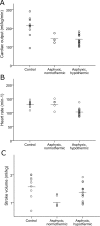Lactate acidosis and cardiac output during initial therapeutic cooling in asphyxiated newborn infants
- PMID: 30870445
- PMCID: PMC6417718
- DOI: 10.1371/journal.pone.0213537
Lactate acidosis and cardiac output during initial therapeutic cooling in asphyxiated newborn infants
Abstract
Aim: We hypothesized that compromised cardiac output in asphyxiated infants may influence on the rate of disappearance of lactate due to insufficient perfusion.
Methods: The study was a prospective, observational study, where infants with perinatal asphyxia who met the criteria for therapeutic hypothermia were included. Cardiac output, stroke volume and heart rate were measured by electrical velocimetry in 15 newborn infants with perinatal asphyxia during the first six hours of active therapeutic hypothermia. Results from routine blood samples were collected retrospectively. Cardiac parameters were also measured in 10 healthy, term infants after caesarian section. Cardiac parameters were compared between the asphyxiated group and the control group prior to and during hypothermia. Rate of disappearance of lactate was correlated to cardiac output in the asphyxiated infants.
Results: Cardiac output was stable in the healthy infants from 0.5 to 6 hours postnatally. The infants with perinatal asphyxia had lower cardiac output prior to and during therapeutic hypothermia compared to the control group. Rate of disappearance of lactate was not related to cardiac output.
Conclusion: An association between disappearance of lactate acidosis and low cardiac output was not confirmed. A low rate of disappearance of lactate may rather be an indicator of organ injury due to asphyxia.
Conflict of interest statement
The authors have declared no competing interests exist.
Figures



References
-
- Shankaran S, Pappas A, Laptook A, MacDonald S, Ehrenkranz R, Tyson J, et al. Outcomes of Safety and Effectiveness in a Multicenter Randomized, Controlled Trial of Whole-Body Hypothermia for Neonatal Hypoxic-Ischemic Encephalopathy. Pediatrics. 2008;122(4):e791 10.1542/peds.2008-0456 - DOI - PMC - PubMed
-
- Martín-Ancel A, García-Alix A, Gayá F, Cabañas F, Burgueros M, Quero J. Multiple organ involvement in perinatal asphyxia. J Pediatr. 1995;127(5):786–93. - PubMed
Publication types
MeSH terms
Substances
Associated data
LinkOut - more resources
Full Text Sources
Miscellaneous

